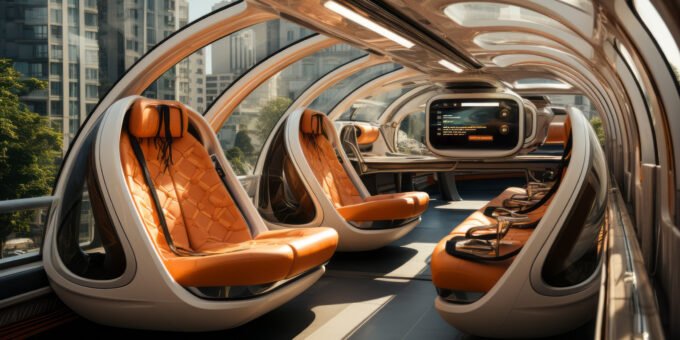
Introduction to the Audi Concept C
The Audi Concept C, unveiled during a significant automotive showcase, marks an important milestone in the evolution of Audi’s design philosophy. This model embodies a bold statement by merging contemporary design sensibilities with nostalgic elements inspired by the vibrant aesthetics of the 1990s. In an industry that constantly seeks innovation, the Concept C serves as a reminder of the rich heritage that shapes current automotive design trends.
A Closer Look at the Interior Design
The Audi Concept C’s interior is a striking homage to the design principles prevalent in the 1990s, encapsulating a unique blend of nostalgia and innovation. As one steps into the cabin, the immediate visual appeal lies in the distinct arrangement of elements that evoke the era’s automotive essence. The dashboard features a combination of angular shapes and rounded edges, reminiscent of the clean, geometric lines that defined 90s design. This thoughtful layout not only reflects aesthetic sensibilities but also prioritizes ergonomics, enhancing the overall driver and passenger experience.
One cannot overlook the materials chosen for the Concept C’s interior. Rich leather upholstery, combined with soft-touch plastics, provides a tactile experience that aligns with the luxurious feel often associated with 90s vehicles. The designers have opted for bold color choices, including deep blues and grays, which were signature tones of the decade. Secondary materials, such as brushed aluminum trims, accentuate the aesthetic without overwhelming the senses, reflecting a minimalist approach rooted in functionality.
In terms of technology, the Audi Concept C does not shy away from modern advancements while maintaining a distinctly retro charm. The integration of digital displays is executed seamlessly, with interfaces framed in classic 90s-inspired geometries. This juxtaposition of vintage and contemporary technology offers a compelling view of how automotive design continues to evolve. Additionally, the layout of controls is intuitive, allowing for easy access without compromising the nostalgic experience.
Ultimately, the interior of the Audi Concept C serves as a successful reinterpretation of 90s design language, successfully merging classic elements with today’s technological innovations. Through this careful analysis, one can appreciate how the concept manages to honor the past while looking toward the future, making it a noteworthy example of automotive creativity.
The Merc Design Boss Perspective
The recent unveiling of the Audi Concept C has sparked a range of opinions within the automotive design community. Among the voices of critique, our attention turns to the Merc Design Boss, whose perspective offers deep insights into the intricacies of this distinctive interior. Notably, their assertion that “the interior looks like it was designed in 1995” raises questions about the balance between nostalgia and the necessity for innovation in modern automotive design.
This comment can be interpreted in several ways. On one hand, for some enthusiasts and collectors, a retro aesthetic can evoke fond memories of an era defined by unique design benchmarks. Automotive brands from the late 20th century often prioritized distinctiveness in materials, shapes, and color palettes. The Audi Concept C might be seen as a tribute to those formative years, appealing to a segment of consumers who value authenticity and personal connection to the past.
However, the critique also points to a significant challenge faced by today’s automotive designers. As technology significantly advances, there is an implicit expectation that car interiors will reflect modern sensibilities, characterized by minimalism, smart device integration, and sustainable materials. In this context, the Merc Design Boss’s critique may imply that the Audi Concept C risks appearing out-of-step with current trends, possibly leading to perceptions of stagnation rather than innovation.
Ultimately, the juxtaposition of retro and contemporary design philosophies is a delicate dance. It raises pertinent questions such as: Is embracing 90s design a calculated homage, or is it an indication of missed opportunities in automotive evolution? Designers must navigate consumer expectations while also pushing the boundaries of creativity, making the assessment of the Audi Concept C’s interior not just a matter of personal taste, but a broader commentary on the state of the industry as a whole.
Conclusion: The Future of Automotive Design?
The Audi Concept C has sparked considerable discussion within the automotive design community, primarily due to its distinctive embrace of 90s design nostalgia. The revival of retro aesthetics not only serves as a homage to an era characterized by bold shapes and vibrant colors but also highlights a broader trend within the industry where manufacturers increasingly look towards the past for inspiration. This approach resonates with a demographic that yearns for authenticity and emotional connection in products, particularly in the context of automotive interior design.
As the automotive landscape evolves, there is a growing consensus that design will continue to be heavily influenced by consumer preferences. Many buyers are now expressing a desire for interiors that reflect their individuality, steering away from the previously sleek and minimalistic designs that have dominated recent years. The appeal of the Audi Concept C, with its charming nods to 90s stylistic elements, indicates that there is a potential market for vehicles that marry modern technology with nostalgic design principles.
Looking ahead, the question remains whether the embrace of 90s aesthetics is merely a passing trend or a more profound shift in automotive philosophy. Many industry experts believe that the success of concepts like Audi’s could incentivize other manufacturers to explore retro-inspired designs in their future models. This could lead to a diversification of automotive interior styles, allowing for a broader range of consumer choices. As car manufacturers continue to innovate while simultaneously acknowledging their heritage, the blending of nostalgia with modernity may well shape the trajectory of automotive interior design in the years to come.